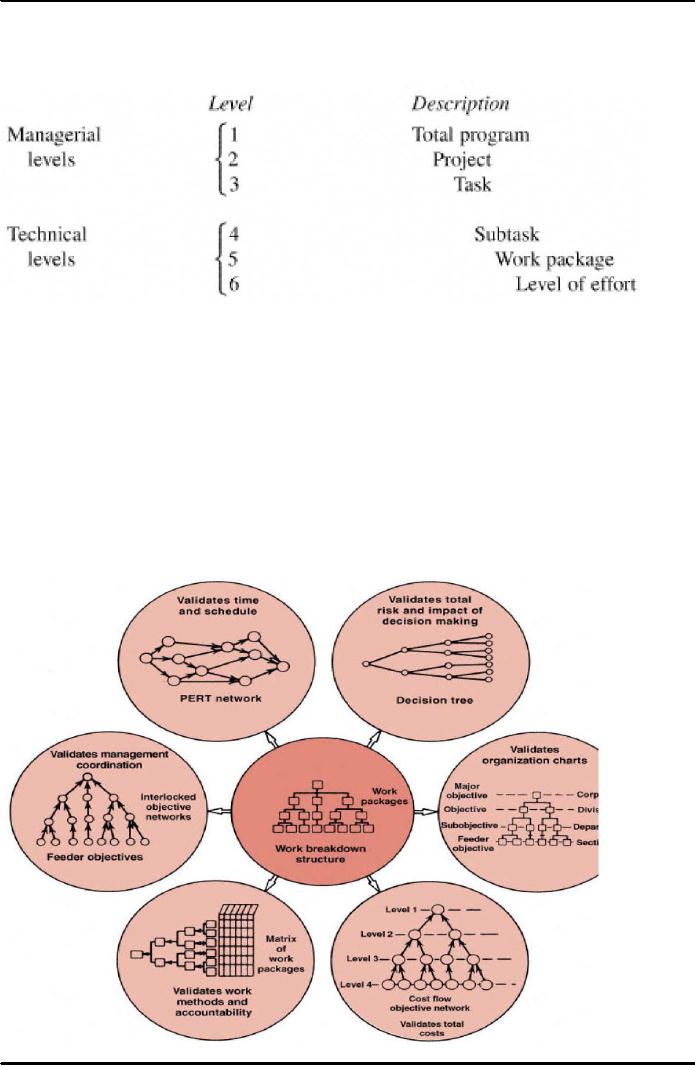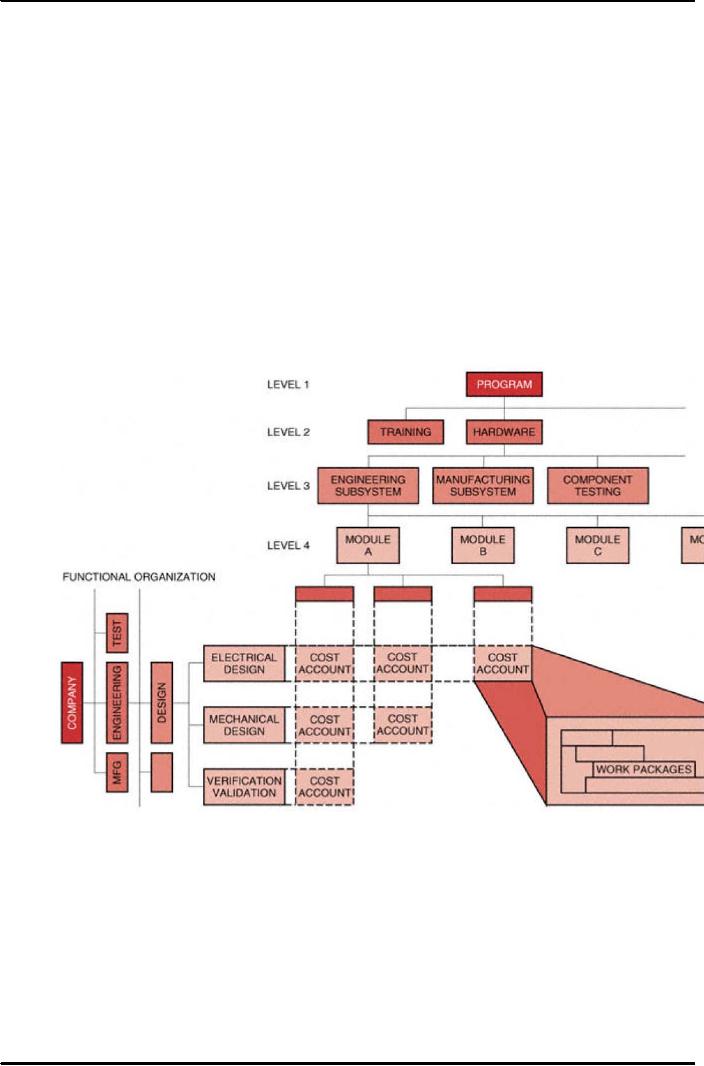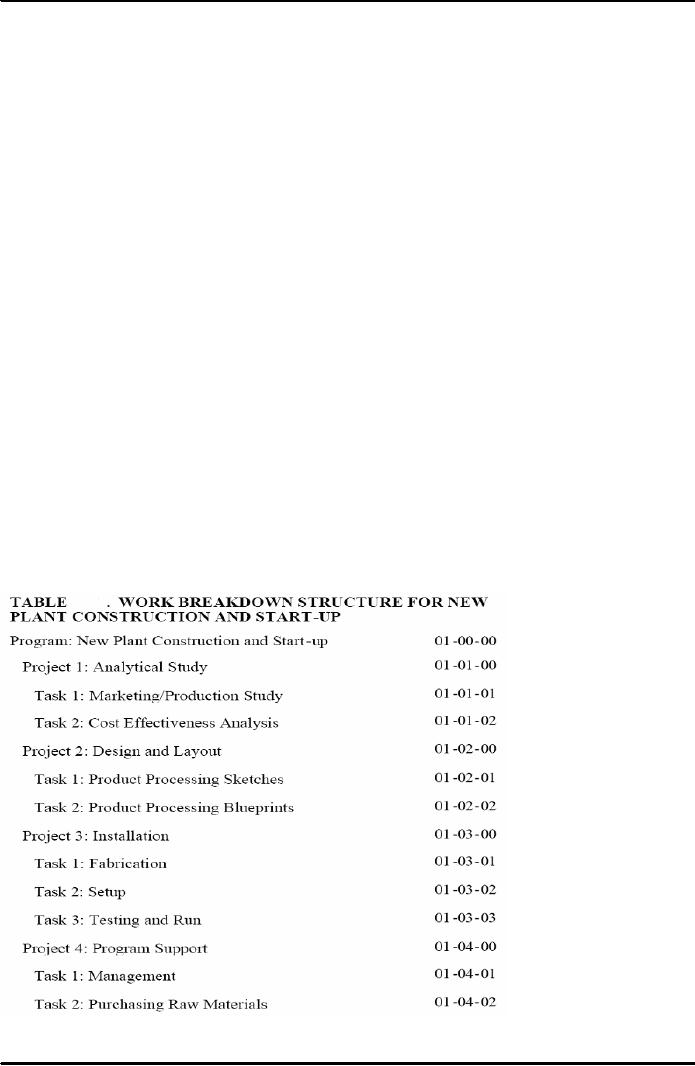 |
WORK BREAKDOWN STRUCTURE:Characteristics of Work Package |
| << PROJECT PLANNING (CONTD.):The Statement of Work (Sow) |
| WORK BREAKDOWN STRUCTURE:Why Do Plans Fail? >> |

Project
Management MGMT627
VU
LESSON
22
WORK
BREAKDOWN STRUCTURE
Broad
Contents
Introduction
Characteristics
of various levels of Work
Breakdown Structure (WBS)
Characteristics
of Work Package
Guidelines
for Work Breakdown Structure
(WBS) by Contractor
Criteria
for Developing Work
Breakdown Structure (WBS)
Work
Breakdown Structure (WBS) Decomposition
Problems
Uses
of Work Breakdown Structure
(WBS)
22.1
Introduction:
In
order to successfully accomplish both contract and
corporate objectives, a plan is
required
that
defines all effort to be expended,
assigns responsibility to a specially
identified
organizational
element, and establishes schedules and
budgets for the accomplishment of
the
work.
The preparation of this plan
is the responsibility of the program manager,
who is assisted
by
the program team assigned in
accordance with program
management system directives.
The
detailed
planning is also established in
accordance with company budgeting
policy before
contractual
efforts are
initiated.
Keeping
this in view, in planning a
project, the project manager
must structure the work
into
small
elements that are:
�
Manageable,
in that specific authority and
responsibility can be
assigned
�
Independent,
or with minimum interfacing
with and dependence on other
ongoing elements
�
Integratable
so that the total package
can be seen
�
Measurable
in terms of progress
After
project requirements definition, the
first major step in the
planning process is the
development
of the Work Breakdown Structure (WBS). A
Work Breakdown Structure
(WBS)
is
a product-oriented family tree
subdivision of the hardware, services, and
data required to
produce
the end product. The Work
Breakdown Structure (WBS) is structured in
accordance
with
the way the work will be
performed and reflects the way in which
project costs and
data
will
be summarized and eventually reported.
Preparation of the Work Breakdown
Structure
(WBS)
also considers other areas
that require structured data,
such as scheduling,
configuration
management,
contract funding, and technical performance
parameters. It is the single
most
important
element because it provides a common
framework from which:
�
Total
program can be described as a summation of
subdivided elements
�
Planning
can be performed
�
Costs
and budgets can be established
�
Time,
cost, and performance can be
tracked
�
Objectives
can be linked to company resources in a
logical manner
�
Schedules
and status-reporting procedures can be
established
�
Network
construction and control planning
can be initiated
�
Responsibility
assignments for each element
can be established
Note
that the Work Breakdown Structure
(WBS) acts as a vehicle for
breaking the work
down
into
smaller elements, thus providing a
greater probability that every
major and minor
activity
will
be accounted for.
151

Project
Management MGMT627
VU
Although
a variety of Work Breakdown Structure
(WBS) exist, the most common is the
six-
level
indented structure shown as Figure 22.1
below:
Figure
22.1: Six-Level
Indented Structure
As
the figure shows, Level 1 is the
total program and is composed of a
set of projects. The
summation
of the activities and costs associated
with each project must
equal the total
program.
Each
project, however, can be
broken down into tasks,
where the summation of all tasks
equals
the
summation of all projects, which, in
turn, comprises the total
program. The reason for
this
subdivision
of effort is simply ease of
control. Program management therefore,
becomes
synonymous
with the integration of activities,
and the project manager acts
as the integrator,
using
the work breakdown structure as the common
framework.
It
is important that careful
consideration must be given to the design
and development of the
Work
Breakdown Structure (WBS). It can be
used to provide the basis
for the following:
Figure
22.2: Work
Breakdown Structure (WBS) for
Objective Control and
Evaluation
152

Project
Management MGMT627
VU
�
Responsibility
matrix
�
Network
scheduling
�
Costing
�
Risk
analysis
�
Organizational
structure
�
Coordination
of objectives
�
Control
(including contract
administration)
22.2
Characteristics
of Various Levels of the
Work Breakdown Structure
(WBS):
As
depicted in Figure 22.1
(above), the upper three levels of the
Work Breakdown Structure
(WBS)
are normally specified by the
customer (if part of a
Request for Proposal (RFP)/Request
for
Quotation (RFQ) (i.e. RFP/RFQ) as the
summary levels for reporting
purposes. The lower
levels
are generated by the contractor for
in-house control. Each level
serves a vital purpose:
Level
1 is generally used for the
authorization and release of
all work, budgets are
prepared at
level
2, and schedules are prepared at
level 3. Certain characteristics
can now be generalized
for
these
levels:
�
Firstly,
The top three levels of the
Work Breakdown Structure (WBS)
reflect integrated
efforts
and should not be related to one
specific department. Effort required by
departments
or
sections should be defined in
subtasks and work
packages.
�
The
summation of all elements in one level
must be the sum of all work
in the next lower
level.
�
Each
element of work should be assigned to one
and only one level of
effort. For example,
the
construction of the foundation of a house
should be included in one project
(or task), not
extended
over two or three. (At level
5, the work packages should be
identifiable and
homogeneous.)
�
The
level at which the project is
managed is generally called the
work package level.
Actually,
the work package can exist
at any level below level
one.
�
The
Work Breakdown Structure (WBS)
must be accompanied by a description of the
scope
of
effort required, or else
only those individuals who
issue the Work Breakdown
Structure
(WBS)
will have a complete understanding of
what work has to be accomplished. It
is
common
practice to reproduce the customer's statement of
work as the description for
the
Work
Breakdown Structure (WBS).
�
It
is often the best policy for
the project manager, regardless of his
technical expertise, to
allow
all of the line managers to
assess the risks in the Work Breakdown
Structure (WBS).
After
all, the line managers are
usually the recognized experts in the
organization.
It
is normally the duty of the project
managers to manage at the top three
levels of the Work
Breakdown
Structure (WBS) and they prefer to
provide status reports to management at
these
levels
also. Some companies are
trying to standardize reporting to
management by requiring the
top
three levels of the Work Breakdown
Structure (WBS) to be the same for
every project, the
only
differences being in levels
46. For companies with
a great deal of similarity among
projects,
this approach has merit. For
most companies, however, the
differences between
projects
make it almost impossible to standardize the top
levels of the Work
Breakdown
Structure
(WBS).
As
shown in the Figure 22.1 (above), the
work package is the critical
level for managing a
Work
Breakdown Structure (WBS). However, it is
possible that the actual management of
the
work
packages are supervised and
performed by the line managers
with status reporting
provided
to the project manager at higher
levels of the Work Breakdown Structure
(WBS).
153

Project
Management MGMT627
VU
To
explain them further, work
packages are natural
subdivisions of cost accounts and
constitute
the
basic building blocks used
by the contractor in planning,
controlling, and measuring contract
performance.
A work package is simply a
low-level task or job
assignment. It describes the
work
to be accomplished by a specific performing
organization or a group of cost
centers and
serves
as a vehicle for monitoring
and reporting progress of
work. Documents that
authorize
and
assign work to a performing
organization are designated by various
names throughout
industry.
Here,
it is important to know what a
work package is. "Work
package" is the generic term
used
in
the criteria to identify discrete tasks
that have definable end results.
Ideal
work packages are
80
hours and less than 24
weeks. However, this may
not be possible on large projects.
It
is not necessary that work
package documentation contain complete,
stand-alone descriptions.
Supplemental
documentation may augment the work
package descriptions. However, the
work
package
descriptions must permit cost
account managers and work
package supervisors to
understand
and clearly distinguish one
work package effort from
another. In the review of
work
package
documentation, it may be necessary to
obtain explanations from personnel
routinely
involved
in the work, rather than requiring the
work package descriptions to be
completely self-
explanatory.
Figure
22.3: The
cost account
intersection
The
desirability of having short-term work
packages is a key feature
from the standpoint of
evaluation
accomplishment. This requirement is not
intended to force arbitrary
cutoff points
154

Project
Management MGMT627
VU
Keeping
this in view, in setting up the
Work Breakdown Structure (WBS),
tasks should:
�
Have
clearly defined start and end
dates
�
Be
usable as a communications tool in which
results can be compared with
expectations
�
Be
estimated on "total" time duration,
not when the task must
start or end
�
Be
structured so that a minimum of project
office control and documentation
(that is, forms)
is
necessary
22.3
Characteristics
of Work Package:
In
case of large projects, planning
will be time phased at the
work package level of the
Work
Breakdown
Structure (WBS). The work
package has the following
characteristics:
�
Represents
units of work at the level where the
work is performed
�
Clearly
distinguishes one work package from
all others assigned to a
single functional
group
�
Contains
clearly defined start and
end dates that are
representative of physical
accomplishment
�
Specifies
a budget in terms of dollars, man-hours,
or other measurable
units
�
Limits
the work to be performed to relatively
short periods of time to minimize the
work-in
process
effort
The
following table (table 22.1)
shows a simple Work
Breakdown Structure (WBS) with
the
associated
numbering system following the
work breakdown. The first
number represents the
total
program (in this case, it is
represented by 01), the second number
represents the project,
and
the third number identifies the task.
Therefore, number 01-03-00 represents
project 3 of
program
01, whereas 01-03-02
represents task 2 of project 3.
This type of numbering
system is
not
standard; each company may have its
own system, depending on how
costs are to be
controlled.
Table
22.1: Work
Breakdown Structure (WBS) for
New Plant Construction and
Start-Up
155

Project
Management MGMT627
VU
By
now we can say that the
preparation of the work breakdown
structure is not easy. The
Work
Breakdown
Structure (WBS) is a communications tool,
providing detailed information
to
different
levels of management. If it does
not contain enough levels,
then the integration of
activities
may prove difficult. If too
many levels exist, then
unproductive time will be
made to
have
the same number of levels for
all projects, tasks, and so
on.
It
is vital that each major
work element should be considered by
itself. Remember, the Work
Breakdown
Structure (WBS) establishes the number of
required networks for cost
control.
In
case of many programs, the customer
establishes the Work
Breakdown Structure (WBS).
22.4
Guidelines
for WBS by
Contractor:
To
explain this, we take the
example of a contractor who is required
to develop a Work
Breakdown
Structure
(WBS). He must consider certain
guidelines. A partial list is as
follows:
�
Complexity
and technical requirements of the program
(i.e., the statement of
work)
�
Program
cost
�
Time
span of the program
�
Contractor's
resource requirements
�
Contractor's
and customer's internal structure for
management control and
reporting
�
Number
of subcontracts
Remember
that applying these
guidelines serves only to
identify the complexity of the
program.
These
data must then be subdivided
and released, together with
detailed information, to the
different
levels
of the organization. The Work
Breakdown Structure (WBS) should
follow specified
criteria
because,
although the program office performs
preparation of the Work Breakdown
Structure
(WBS),
the actual work is performed by the
doers, not the planners. Both the
doers and the planners
must
be in agreement as to what is
expected.
22.5
Criteria
for Developing Work
Breakdown Structure
(WBS):
Following
is a sample listing of criteria
for developing a Work
Breakdown Structure (WBS):
�
The
Work Breakdown Structure (WBS) and
work description should be
easy to understand.
�
All
schedules should follow the
Work Breakdown Structure
(WBS).
�
No
attempt should be made to subdivide
work arbitrarily to the lowest possible
level. The
lowest
level of work should not
end up having a ridiculous
cost in comparison to other
efforts.
�
Since
scope of effort can change
during a program, every
effort should be made to
maintain
flexibility
in the Work Breakdown Structure
(WBS).
�
The
Work Breakdown Structure (WBS)
can act as a list of discrete and
tangible milestones
so
that everyone will know
when the milestones were achieved.
�
Level
of the Work Breakdown Structure (WBS)
can reflect the "trust" you
have in certain
line
groups.
�
Work
Breakdown Structure (WBS) can be
used to segregate recurring
from nonrecurring
costs.
�
Most
Work Breakdown Structure (WBS)
elements (at the lowest
control level) range
from
0.5
to 2.5 percent of the total project
budget.
156

Project
Management MGMT627
VU
22.6
Work
Breakdown Structure (WBS)
Decomposition Problems:
Misconceptions
prevail with almost every
thing. There is a common misconception
that the
Work
Breakdown Structure (WBS) decomposition
is an easy task to perform. In
the
development
of the Work Breakdown Structure (WBS),
the top three levels or
management
levels
are usually roll-up
levels.
Preparing
templates at these levels is
becoming common practice. However, at
levels 46 of the
Work
Breakdown Structure (WBS), templates
may not be appropriate.
There are the
following
reasons
for this:
�
Firstly,
breaking the work down to
extremely small and detailed
work packages may
require
the
creation of hundreds or even thousands of
cost accounts and charge
numbers. This could
increase
the management, control, and
reporting costs of these
small packages to a
point
where
the costs exceed the benefits.
Although a typical work
package may be
200300
hours
and approximately two weeks in
duration, consider the impact on a large
project,
which
may have more than one million
direct labor hours.
�
Breaking
the work down to small work
packages can provide
accurate cost control if,
and
only
if, the line managers can
determine the costs at this
level of detail. Line
managers must
be
given the right to tell
project managers that costs
cannot
be
determined at the
requested
level
of detail.
�
The
Work Breakdown Structure (WBS) is the
basis for scheduling techniques
such as the
Arrow
Diagramming Method and the Precedence
Diagramming Method. At low
levels of
the
Work Breakdown Structure (WBS), the
interdependencies between activities
can
become
so complex that meaningful
networks cannot be constructed.
To
cater to the above-mentioned problems, one
solution is to create "hammock"
activities,
which
encompass several activities where exact
cost identification cannot or may
not be
accurately
determined. Some projects identify a
"hammock" activity called
management support
(or
project office), which
includes overall project
management, data items,
management
reserve,
and possibly procurement. The advantage of
this type of hammock activity is
that the
charge
numbers are under the
direct
control
of the project manager.
In
addition to this, there is a common misconception
that the typical dimensions of a
work
package
are approximately 80 hours and less
than two weeks to a month.
Although this may be
true
on small projects, this would
necessitate millions of work
packages on large jobs and
this
may
be impractical, even if line managers
could control work packages
of this size.
Cost
analysis down to the fifth level is
advantageous, from a cost
control point of
view.
However,
it should be noted that the
cost required to prepare cost analysis
data to each lower
level
might increase exponentially,
especially if the customer requires data
to be presented in a
specified
format that is not part of
the company's standard operating
procedures. The
level-5
work
packages are normally for
in-house control only. Some
companies bill
customers
separately
for each level of cost
reporting below level
3.
Another
aspect is that the Work
Breakdown Structure (WBS) can be
subdivided into sub
objectives
with finer divisions of
effort as we go lower into the
Work Breakdown Structure
(WBS).
By defining sub objectives, we add
greater understanding and, it is hoped, clarity
of
action
for those individuals who
will be required to complete the
objectives. Whenever work
is
structured,
understood, easily identifiable, and
within the capabilities of the
individuals, there
will
almost always exist a high
degree of confidence that the
objective can be
reached.
Also,
the Work Breakdown Structure (WBS)
can be used to structure work
for reaching such
objectives
as lowering cost, reducing
absenteeism, improving morale, and
lowering scrap
157

Project
Management MGMT627
VU
factors.
The lowest subdivision now
becomes an end-item or sub-objective,
not necessarily a
work
package as described
here.
Since
we are describing project
management, therefore, for the remainder
of the text we will
consider
the lowest level as the work
package.
22.7
Uses
of Work Breakdown Structure
(WBS):
It
is important to remember that
once the Work Breakdown Structure
(WBS) is established and the
program
is "kicked off," it becomes a
very costly procedure to either add or
delete activities, or
change
levels of reporting because of
cost control. Many companies
do not give careful
forethought
to
the importance of a properly developed
Work Breakdown Structure (WBS), and
ultimately they
risk
cost control problems downstream. One
important use of the Work
Breakdown Structure
(WBS)
is that it serves as a cost
control standard for any
future activities that may
follow on or may
just
be similar. One common mistake made by
management is the combining of direct
support
activities
with administrative activities.
For example, the department manager
for manufacturing
engineering
may be required to provide
administrative support (possibly by
attending team
meetings)
throughout the duration of the program.
If the administrative support is spread
out over
each
of the projects, a false picture is obtained as to the
actual hours needed to accomplish
each
project
in the program. If one of the projects should be
canceled, then the support man-hours for
the
total
program would be reduced
when, in fact, the administrative and
support functions may be
constant,
regardless of the number of projects and
tasks.
It
is quite often that the Work
Breakdown Structure (WBS) accompanying
customer Request for
Proposals
(RFPs), contains much more scope of
effort as specified by the statement of
work than the
existing
funding will support. This is done
intentionally by the customer in hopes
that a contractor
may
be willing to ''buy in." If the
contractor's price exceeds the customer's
funding limitations,
then
eliminating
activities from the Work
Breakdown Structure (WBS) must
reduce the scope of
effort.
By
developing a separate project
for administrative and indirect support
activities, the customer
can
easily
modify his costs by
eliminating the direct support activities
of the canceled effort.
Lastly,
we should also discuss the
usefulness and applicability of the
Work Breakdown Structure
(WBS)
system. Many companies and
industries have been successful in
managing programs without
the
use of work breakdown
structures, especially on repetitive-type
programs.
158
Table of Contents:
- INTRODUCTION TO PROJECT MANAGEMENT:Broad Contents, Functions of Management
- CONCEPTS, DEFINITIONS AND NATURE OF PROJECTS:Why Projects are initiated?, Project Participants
- CONCEPTS OF PROJECT MANAGEMENT:THE PROJECT MANAGEMENT SYSTEM, Managerial Skills
- PROJECT MANAGEMENT METHODOLOGIES AND ORGANIZATIONAL STRUCTURES:Systems, Programs, and Projects
- PROJECT LIFE CYCLES:Conceptual Phase, Implementation Phase, Engineering Project
- THE PROJECT MANAGER:Team Building Skills, Conflict Resolution Skills, Organizing
- THE PROJECT MANAGER (CONTD.):Project Champions, Project Authority Breakdown
- PROJECT CONCEPTION AND PROJECT FEASIBILITY:Feasibility Analysis
- PROJECT FEASIBILITY (CONTD.):Scope of Feasibility Analysis, Project Impacts
- PROJECT FEASIBILITY (CONTD.):Operations and Production, Sales and Marketing
- PROJECT SELECTION:Modeling, The Operating Necessity, The Competitive Necessity
- PROJECT SELECTION (CONTD.):Payback Period, Internal Rate of Return (IRR)
- PROJECT PROPOSAL:Preparation for Future Proposal, Proposal Effort
- PROJECT PROPOSAL (CONTD.):Background on the Opportunity, Costs, Resources Required
- PROJECT PLANNING:Planning of Execution, Operations, Installation and Use
- PROJECT PLANNING (CONTD.):Outside Clients, Quality Control Planning
- PROJECT PLANNING (CONTD.):Elements of a Project Plan, Potential Problems
- PROJECT PLANNING (CONTD.):Sorting Out Project, Project Mission, Categories of Planning
- PROJECT PLANNING (CONTD.):Identifying Strategic Project Variables, Competitive Resources
- PROJECT PLANNING (CONTD.):Responsibilities of Key Players, Line manager will define
- PROJECT PLANNING (CONTD.):The Statement of Work (Sow)
- WORK BREAKDOWN STRUCTURE:Characteristics of Work Package
- WORK BREAKDOWN STRUCTURE:Why Do Plans Fail?
- SCHEDULES AND CHARTS:Master Production Scheduling, Program Plan
- TOTAL PROJECT PLANNING:Management Control, Project Fast-Tracking
- PROJECT SCOPE MANAGEMENT:Why is Scope Important?, Scope Management Plan
- PROJECT SCOPE MANAGEMENT:Project Scope Definition, Scope Change Control
- NETWORK SCHEDULING TECHNIQUES:Historical Evolution of Networks, Dummy Activities
- NETWORK SCHEDULING TECHNIQUES:Slack Time Calculation, Network Re-planning
- NETWORK SCHEDULING TECHNIQUES:Total PERT/CPM Planning, PERT/CPM Problem Areas
- PRICING AND ESTIMATION:GLOBAL PRICING STRATEGIES, TYPES OF ESTIMATES
- PRICING AND ESTIMATION (CONTD.):LABOR DISTRIBUTIONS, OVERHEAD RATES
- PRICING AND ESTIMATION (CONTD.):MATERIALS/SUPPORT COSTS, PRICING OUT THE WORK
- QUALITY IN PROJECT MANAGEMENT:Value-Based Perspective, Customer-Driven Quality
- QUALITY IN PROJECT MANAGEMENT (CONTD.):Total Quality Management
- PRINCIPLES OF TOTAL QUALITY:EMPOWERMENT, COST OF QUALITY
- CUSTOMER FOCUSED PROJECT MANAGEMENT:Threshold Attributes
- QUALITY IMPROVEMENT TOOLS:Data Tables, Identify the problem, Random method
- PROJECT EFFECTIVENESS THROUGH ENHANCED PRODUCTIVITY:Messages of Productivity, Productivity Improvement
- COST MANAGEMENT AND CONTROL IN PROJECTS:Project benefits, Understanding Control
- COST MANAGEMENT AND CONTROL IN PROJECTS:Variance, Depreciation
- PROJECT MANAGEMENT THROUGH LEADERSHIP:The Tasks of Leadership, The Job of a Leader
- COMMUNICATION IN THE PROJECT MANAGEMENT:Cost of Correspondence, CHANNEL
- PROJECT RISK MANAGEMENT:Components of Risk, Categories of Risk, Risk Planning
- PROJECT PROCUREMENT, CONTRACT MANAGEMENT, AND ETHICS IN PROJECT MANAGEMENT:Procurement Cycles